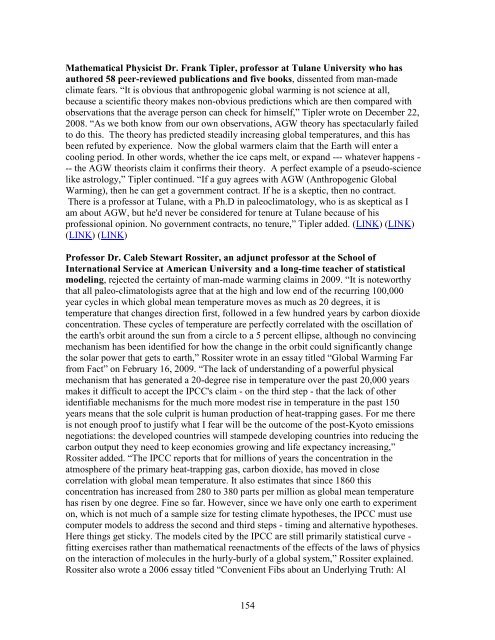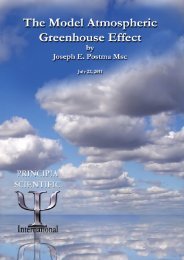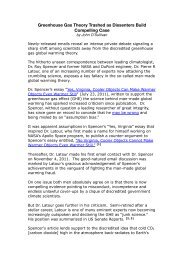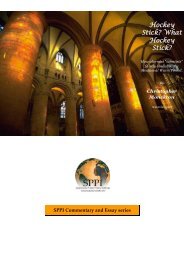Than 1000 International Scientists Dissent Over Man-Made Global ...
Than 1000 International Scientists Dissent Over Man-Made Global ...
Than 1000 International Scientists Dissent Over Man-Made Global ...
Create successful ePaper yourself
Turn your PDF publications into a flip-book with our unique Google optimized e-Paper software.
Mathematical Physicist Dr. Frank Tipler, professor at Tulane University who has<br />
authored 58 peer-reviewed publications and five books, dissented from man-made<br />
climate fears. ―It is obvious that anthropogenic global warming is not science at all,<br />
because a scientific theory makes non-obvious predictions which are then compared with<br />
observations that the average person can check for himself,‖ Tipler wrote on December 22,<br />
2008. ―As we both know from our own observations, AGW theory has spectacularly failed<br />
to do this. The theory has predicted steadily increasing global temperatures, and this has<br />
been refuted by experience. Now the global warmers claim that the Earth will enter a<br />
cooling period. In other words, whether the ice caps melt, or expand --- whatever happens -<br />
-- the AGW theorists claim it confirms their theory. A perfect example of a pseudo-science<br />
like astrology,‖ Tipler continued. ―If a guy agrees with AGW (Anthropogenic <strong>Global</strong><br />
Warming), then he can get a government contract. If he is a skeptic, then no contract.<br />
There is a professor at Tulane, with a Ph.D in paleoclimatology, who is as skeptical as I<br />
am about AGW, but he'd never be considered for tenure at Tulane because of his<br />
professional opinion. No government contracts, no tenure,‖ Tipler added. (LINK) (LINK)<br />
(LINK) (LINK)<br />
Professor Dr. Caleb Stewart Rossiter, an adjunct professor at the School of<br />
<strong>International</strong> Service at American University and a long-time teacher of statistical<br />
modeling, rejected the certainty of man-made warming claims in 2009. ―It is noteworthy<br />
that all paleo-climatologists agree that at the high and low end of the recurring 100,000<br />
year cycles in which global mean temperature moves as much as 20 degrees, it is<br />
temperature that changes direction first, followed in a few hundred years by carbon dioxide<br />
concentration. These cycles of temperature are perfectly correlated with the oscillation of<br />
the earth's orbit around the sun from a circle to a 5 percent ellipse, although no convincing<br />
mechanism has been identified for how the change in the orbit could significantly change<br />
the solar power that gets to earth,‖ Rossiter wrote in an essay titled ―<strong>Global</strong> Warming Far<br />
from Fact‖ on February 16, 2009. ―The lack of understanding of a powerful physical<br />
mechanism that has generated a 20-degree rise in temperature over the past 20,000 years<br />
makes it difficult to accept the IPCC's claim - on the third step - that the lack of other<br />
identifiable mechanisms for the much more modest rise in temperature in the past 150<br />
years means that the sole culprit is human production of heat-trapping gases. For me there<br />
is not enough proof to justify what I fear will be the outcome of the post-Kyoto emissions<br />
negotiations: the developed countries will stampede developing countries into reducing the<br />
carbon output they need to keep economies growing and life expectancy increasing,‖<br />
Rossiter added. ―The IPCC reports that for millions of years the concentration in the<br />
atmosphere of the primary heat-trapping gas, carbon dioxide, has moved in close<br />
correlation with global mean temperature. It also estimates that since 1860 this<br />
concentration has increased from 280 to 380 parts per million as global mean temperature<br />
has risen by one degree. Fine so far. However, since we have only one earth to experiment<br />
on, which is not much of a sample size for testing climate hypotheses, the IPCC must use<br />
computer models to address the second and third steps - timing and alternative hypotheses.<br />
Here things get sticky. The models cited by the IPCC are still primarily statistical curve -<br />
fitting exercises rather than mathematical reenactments of the effects of the laws of physics<br />
on the interaction of molecules in the hurly-burly of a global system,‖ Rossiter explained.<br />
Rossiter also wrote a 2006 essay titled ―Convenient Fibs about an Underlying Truth: Al<br />
154





